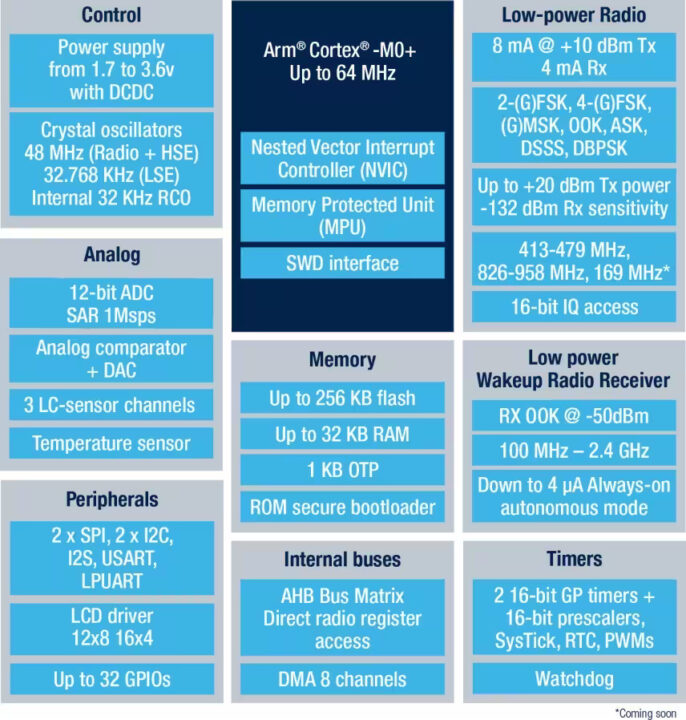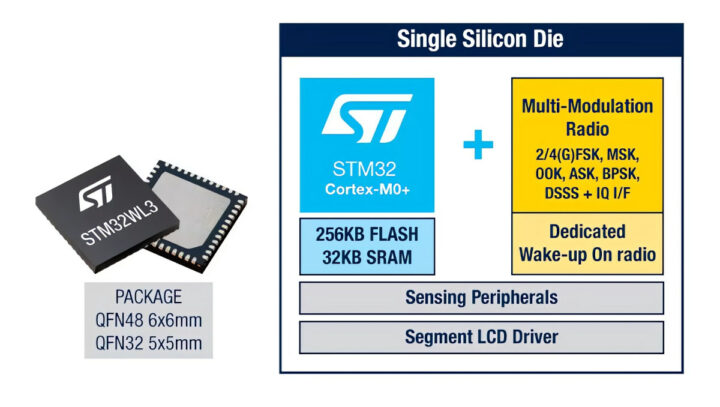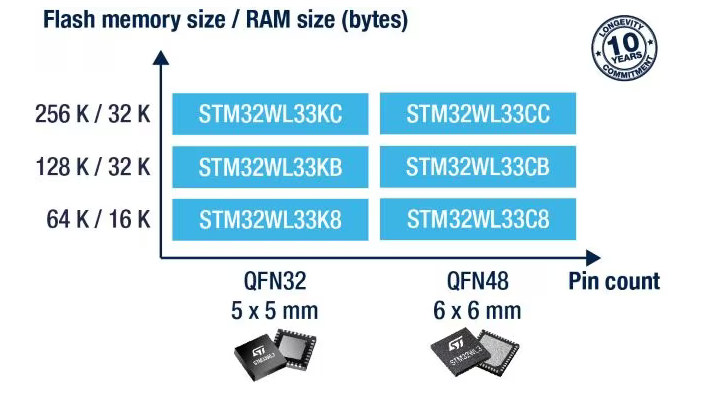STMicroelectronics STM32WL3 is an Arm Cortex-M0+ low-power, long-range, multi-protocol wireless microcontroller working in sub-GHz ISM frequency bands, namely 413MHz – 479MHz, 826MHz – 958MHz, and soon 169MHz (2024) for protocols such as wireless M-Bus (mode N) and Wize.
The multi-protocol and multi-modulation radio supports 4-(G)FSK up to 600kbit/s, 2-(G)FSK, (G)MSK, DBPSK, DSSS, OOK, ASK modulation schemes suitable for proprietary and standardized wireless protocols such as Sigfox, KNX, WiSun, mioty, M-Bus, and others. STMicro also claims to have implemented new power-saving features that extend the battery life to up to 15 years.
STM32WL3 key features and specifications:
- MCU Core – Arm Cortex-M0+ up to 64 MHz
- Memory – 16KB or 32KB SRAM with full retention
- Storage
- 128KB or 256KB flash
- 1 KB OTP flash (user data)
- Wireless
- RF bands – 413-479 MHz, 826-958 MHz, and soon 169 MHz
- Data rate – 0.1 to 600 kbit/s
- Tx power – up to +20dBm
- Rx sensitivity @ 1% BER – -132 dBm
- Modulation schemes
- 2(G)FSK, 4(G)FSK, OOK, ASK, D-BPSK, DSSS (direct sequence spread spectrum)
- I/Q channels data access
- Compatible with proprietary and standardized wireless protocols (W-MBUS, Sigfox, Mioty, KNX-RF, IEEE 802.15.4g, others)
- Certifications
- Europe – ETSI EN 300 220, category 1 compliant, ETSI EN 303 131
- US – FCC part 15 and part 90
- Japan – ARIB STD T67, T108
- Configurable hardware sequencer for autonomous radio operations (Sniff mode, Frequency hopping, Low Duty Cycle mode, Listen before talk)
- Wakeup radio receiver – Low power autonomous wakeup receiver (LPAWUR) with OOK data receiver channel, -50 dBm sensitivity
- Peripherals
- Display – LCD driver with up to 96 (12×8) or 64 (16×4) matrix elements
- Up to 32x GPIOs (VFQFPN48) or 17x GPIOs (QFN32)
- 1x USART with support for LIN, Smartcard Protocol, IrDA, SIR ENDEC specifications, and modem operations (CTS/RTS)
- 1x LPUART (available also in low-power mode) with wakeup capability
- 1x SPI, 1x SPI with I2S interface multiplexed
- 2x I2C (SMBus/PMBus)
- 8-channel DMA controller supporting ADC, DAC, SPIs, I2Cs, USART, LPUART, timers, AES
- Analog
- 12-bit ADC up to 1 Msample/s with 8 single-ended channels (or 4 differentials)
- 1x comparator
- 1x 6-bit sample-and-hold DAC output
- LC sensor controller (for autonomous rotary-wheel-based flow metering)
- Battery voltage monitoring with low-level detection
- Temperature monitoring
- Clock sources and timers
- Clocking scheme with
- 64 MHz HSI or PLL
- Fail-safe 48 MHz crystal oscillator (HSE) with integrated trimming capacitors
- 32 kHz crystal oscillator (LSE)
- Integrated low-power 32 kHz RC (LSI)
- 1x 16-bit 4-channel general-purpose timer
- 1x 16-bit 2-channel general-purpose timer
- 1x RTC
- 1x independent watchdog
- Radio timer with wake-up capability
- Clocking scheme with
- Security
- Secure bootloader with SWD disabling
- AES-128 co-processor and 16-bit TRNG
- Embedded UART bootloader with selectable write and read-out protection
- Power Management
- Supply voltage – 1.7 to 3.6V DC
- Ultra-low-power power-on-reset (POR) and power-down-reset (PDR)
- Programmable voltage detector (PVD)
- Current consumption
- Dynamic current consumption: 14 µA/MHz
- Wake up radio receiver – 4 µA in always-on autonomous mode
- 14 nA in Shutdown mode
- 960 nA in Deepstop mode
- Radio only consumption
- 4 mA in RX
- 8 mA in TX @ +10 dBm
- 78 mA in TX @ +20 dBm
- Consumption: 1.6 mA current in WFI conditions (direct HSE mode)
- Wakeup capability from both Deepstop and Shutdown modes
- Packages – QFN32 (5x5mm) or QFN48 (6x6mm); ECOPACK2 compliant
- Temperature Range – Up to extended: -40ºC to 105ºC

STMicro did not mention software in this announcement, but as I understand it’s supported by the STM32CubeIDE ecosystem like other wireless or non-wireless STM32 microcontrollers. Evaluation/development kits will be available soon, but we do not have details at this time.
The STM32WL3 will be launched with six SKUs initially with different flash and RAM sizes and packages, namely STM32WL33K8, STM32WL33C8, STM32WL33KB, STM32WL33CB, STM32WL33KC, and STM32WL33CC as described in the chart below.
The STM32WL3 wireless MCUs are expected to be integrated into remotely deployed applications such as metering and monitoring devices, as well as alarm systems, actuators, and sensors found in smart buildings, smart factories, and smart cities. STMicro says prices start from $2.04 for orders of 10,000 pieces, and the company guarantees longevity for at least 10 years. Further information may be found on the product page and in the press release.

Jean-Luc started CNX Software in 2010 as a part-time endeavor, before quitting his job as a software engineering manager, and starting to write daily news, and reviews full time later in 2011.
Support CNX Software! Donate via cryptocurrencies, become a Patron on Patreon, or purchase goods on Amazon or Aliexpress







that looks like an interesting chip
32GB SRAM in this kind of MCU is simply stellar value for the money! 😉
I’m confused, none of those frequencies is ISM, according to https://en.wikipedia.org/wiki/ISM_radio_band
433MHz and 902-928MHz are in the table on that page…
868MHz is too.
any devkit ?
Coming soon…